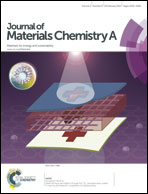Synthesis of polyaniline nanotubes using the self-assembly behavior of vitamin C: a mechanistic study and application in electrochemical supercapacitors†
Abstract
Herein, we report the discovery of an unprecedented behavior of vitamin C to form a rod-like assembly through hydrogen-bonding in water, which, upon the addition of aniline monomer, produces polyaniline (PANI) nanotubes via the oxidative polymerization method. It was observed that tubular growth of PANI at the nanometer scale can be controlled by varying the molar ratio of vitamin C to aniline. At a molar ratio of 0.25 (i.e. [Vitamin C]/[Aniline] = 0.25), long and uniform nanotubes which extended to several micrometers with an outer diameter (OD) in the range of 80–120 nm were observed. We have also demonstrated the efficient electrochemical properties of novel PANI nanotube based electrodes which showed higher capacitance and energy density values of 714.68 and 99.34 W h kg−1 at 0.5 mA, respectively. The observed results were compared and justified with the theoretical capacitance value.


 Please wait while we load your content...
Please wait while we load your content...